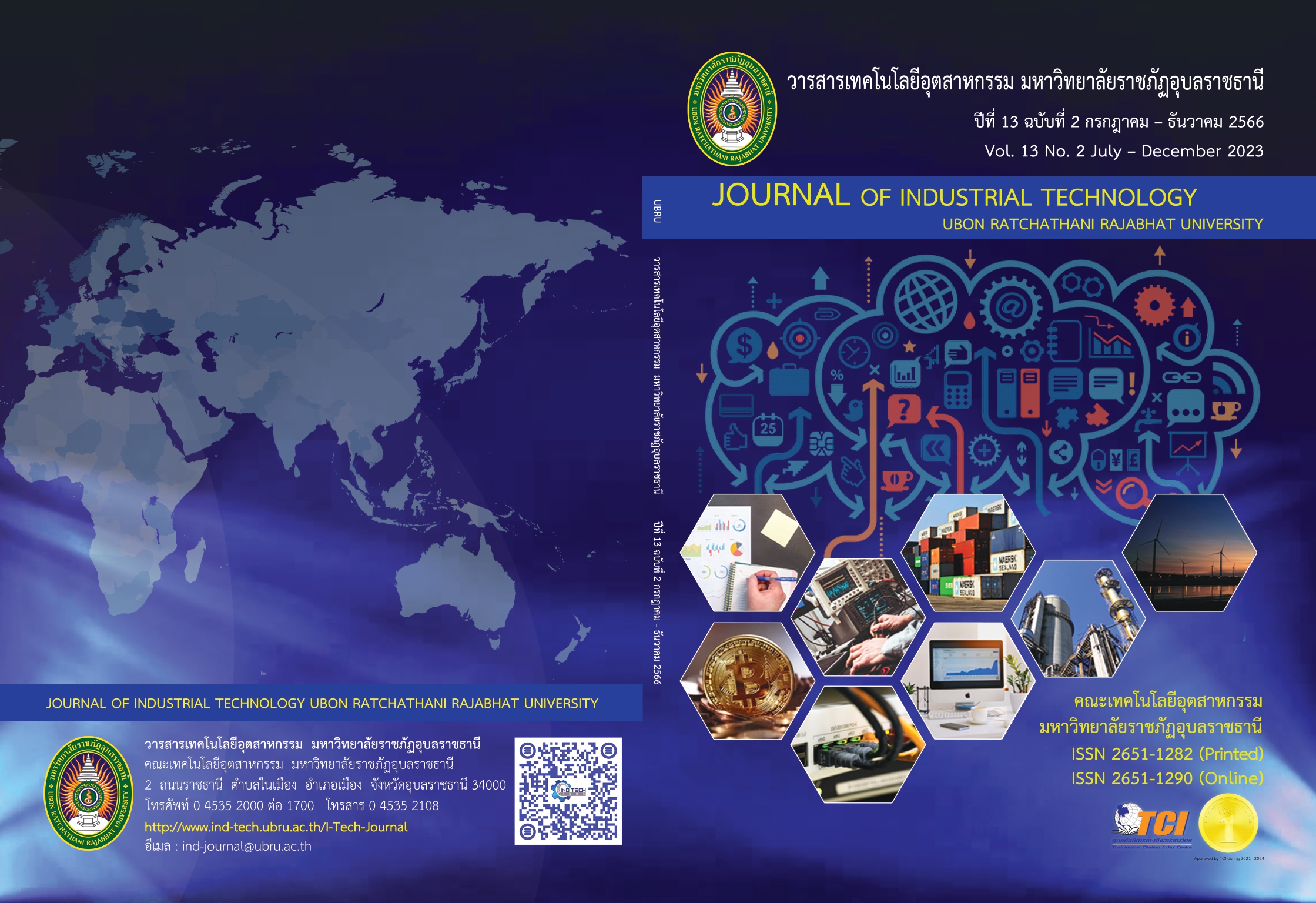Preparation of Composite Beads from Surfactant-modified Montmorillonite Clay for Reactive Black 5 Dye Adsorption
Main Article Content
บทคัดย่อ
Contamination of synthetic dyes in natural bodies of water harms aquatic lives and humans. These dyes must be removed before discharge. Adsorption by the adsorbent, which is of natural origin, low cost, and abundance in Thailand, is gaining popularity. The objective of this research is to develop a composite bead made from montmorillonite clay modified by a cationic surfactant (OMMT) and chitosan (CTS) as an adsorbent for the adsorption of the reactive black 5 dye (RB5) in a batch system. The design of experiments was based on the Box-Behnken approach with three factors (the mass of the surfactant (Tetradecyltrimethylammonium bromide, TTAB), OMMT, and CTS) and three levels. In addition, the response surface model was used to investigate the relationship between three factors and to determine the optimum composition. The experimental results revealed that all three factors positively affected the removal of RB5. The dye removal was strongly influenced by the mass of CTS. The optimum composition of the composite bead was found to be 0.33 g TTAB, 0.18 g OMMT, and 0.036 g CTS with the predicted dye removal efficiency of 80.27%. The proposed model can effectively predict the dye uptake under defined adsorption conditions and the use of a composite bead as the adsorbent can reduce the expense of recovery from liquid after the adsorption process.
Article Details

อนุญาตภายใต้เงื่อนไข Creative Commons Attribution-NonCommercial-NoDerivatives 4.0 International License.
บทความที่ได้รับการตีพิมพ์ในวารสารฯ ท้ังในรูปแบบของรูปเล่มและอิเล็กทรอนิกส์เป็นลิขสิทธิ์ของวารสารฯ
เอกสารอ้างอิง
Felista M, Wanyonyi W, Ongera G. Adsorption of anionic dye (Reactive black 5) using macadamia seed Husks: Kinetics and equilibrium studies. Scientific African. 2020; 7:e00283.
Jalali Sarvestani M, Doroudi, Z. Removal of reactive black 5 from waste waters by adsorption: A Comprehensive Review. Journal of Water and Environmental Nanotechnology. 2020; 5(2): 180-90.
De Luca P, Nagy J. Treatment of water contaminated with reactive black-5 dye by carbon nanotubes. Materials. 2020; 13(23): 5508.
Mahmoodi N, Taghizadeh A, Taghizadeh M, AZimi Shahali Baglou M. Surface modified montmorillonite with cationic surfactants: Preparation, characterization, and dye adsorption from aqueous solution. Journal of Environmental Chemical Engineering. 2019; 7(4): 103243.
Namdaung P, Umpuch C. Adsorption of reactive red 120 onto cationic surfactant intercalated montmorillonite clay. UBU Engineering Journal. 2019; 12(2): 1-12.
Biglari H, Rodríguezí Couto S, Khaniabadi Y, Nourmoradi H, Khoshgoftar M, Amrane A, Vosoughi M, Esmaeili S, Heydari R, Mohammadi M, Rashidi R. Cationic surfactant-modified clay as an adsorbent for the removal of synthetic dyes from aqueous solutions. International Journal of Chemical Reactor Engineering. 2018; 16(5): 1-14.
Jia J, Liu Y, Sun S. Preparation and characterization of chitosan/bentonite composites for cr (vi) removal from aqueous solutions. Adsorption Science & Technology. 2021; 1-15.
Dotto G, Ocampo-Pérez R, Moura J, Cadaval T, Pinto L. Adsorption rate of reactive black 5 on chitosan based materials: geometry and swelling effects. Adsorption. 2016; 22(7): 973-83.
Mohammad A, Abdulhameed A, Jawad A. Box-Behnken design to optimize the synthesis of new crosslinked chitosan-glyoxal/TiO2 nanocomposite: Methyl orange adsorption and mechanism studies. International Journal of Biological Macromolecules. 2019; 129: 98-109.
Nourmoradi H, Avazpour M, Ghasemian N, Heidari M, Moradnejadi K, Khodarahmi F, Javaheri F, Moghadam M. Surfactant modified montmorillonite as a low-cost adsorbent for 4-chlorophenol: Equilibrium, kinetic and thermodynamic study. Journal of the Taiwan Institute of Chemical Engineers. 2016; 59: 244-51.
Daud Z, Nasir N, Awang H, Ab Aziz N, Ahmad B, Ridzuan M et al. Chitosan beads as an adsorbent for the removal of colour from natural rubber wastewater. International Journal of Integrated Engineering. 2018;10(9).
Du X, Kishima C, Zhang H, Miyamoto N, Kano N. Removal of chromium(vi) by chitosan beads modified with sodium dodecyl sulfate (SDS). Applied Sciences. 2020; 10(14): 4745.
Tran T, Huong Do T, Hoang M, Nguyen D, Le Q, Nguyen D, Ngo T. Rapid and sensitive detection of clenbuterol using a fluorescence nanosensor based on diazo coupling mechanism. Advances in Natural Sciences: Nanoscience and Nanotechnology. 2015; 6(2): 025007.
Yan-Min Z. Study on naphthalene sulfonic acid formaldehyde condensate by ultraviolet absorption spectrum. Journal of Physics: Conference Series. 2019; 1237(2): 022107.
Umpuch C, SongSak S. Adsorption characteristics of reactive black 5 onto chitosan-intercalated montmorillonite. Desalination and Water Treatment. 2013; 53(11): 1-9.
Karadag D, Turan M, Akgul E, Tok S, Faki A. Adsorption equilibrium and kinetics of reactive black 5 and reactive red 239 in aqueous solution onto surfactant modified zeolite. Journal of Chemical & Engineering Data. 2007; 52(5): 1615-20.
Li J, Cai J, Zhong L, Wang H, Cheng H, Ma Q. Adsorption of reactive dyes onto chitosan/ montmorillonite intercalated composite: multi-response optimization, kinetic, isotherm and thermodynamic study. Water Science and Technology. 2018; 77(11): 2598-612.


